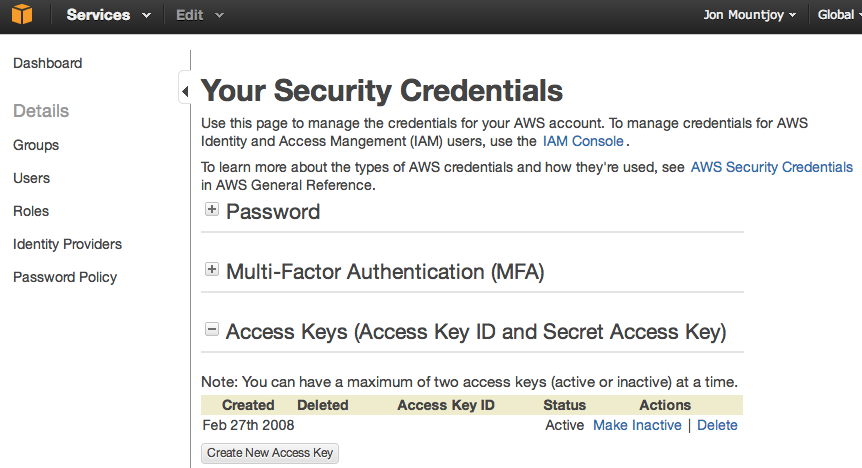How Do Aws S3 And Heroku Apps Link
Using AWS S3 to Store Static Assets and File Uploads
Last updated May 27, 2020
Table of Contents
- Overview
- S3 setup
- Static assets
- File uploads
Amazon Simple Storage Service (S3) is a "highly durable and available store" that is ideal for storing application content such as media files, static assets, and user uploads.
S3 allows you to offload the storage of static files from your app. This is crucial on Heroku, because your app's dynos have an ephemeral filesystem. This means that all files that aren't part of your application's slug are lost whenever a dyno restarts or is replaced (this happens at least once daily).
Overview
All files in S3 are stored in buckets. Buckets act as a top-level container, much like a directory. All files sent to S3 belong to a bucket, and a bucket's name must be unique across all of S3.
Access to the S3 API is governed by an Access Key ID and a Secret Access Key. The access key identifies your S3 user account, and the secret key is a password-like credential that should be stored securely.
S3 setup
Enabling an application to use S3 requires that the application have access to the AWS credentials as well as the name of the bucket to store files.
Credentials
Your S3 credentials can be found on the Security Credentials section of the AWS "My Account/Console" menu

Because of the sensitive nature of your S3 credentials, you should never commit them to version control. Instead, set them as the values of config vars for the Heroku apps that will use them.
Use the heroku config:set to set both keys:
$ heroku config:set AWS_ACCESS_KEY_ID=xxx AWS_SECRET_ACCESS_KEY=yyy Adding config vars and restarting app... done, v21 AWS_ACCESS_KEY_ID => xxx AWS_SECRET_ACCESS_KEY => yyy Bucket
Make sure you create your S3 bucket in the same region as the app that will use it. This takes advantage of AWS's free in-region data transfer rates.
A single bucket typically stores the files, assets, and uploads for an application. To create a bucket, access the S3 section of the AWS Management Console and create a new bucket in the US Standard region:

Although you have a lot of freedom in choosing a bucket name, take care in choosing a name to ensure maximum interoperability.
Store the bucket name in a config var to give your application access to its value:
$ heroku config:set S3_BUCKET_NAME=appname-assets Adding config vars and restarting app... done, v22 S3_BUCKET_NAME => appname-assets Naming buckets
Your S3 bucket's name can have unintended effects on which features of AWS you can use, including basic features like encryption. To ensure maximum compatibility, the ideal bucket name has:
- 32 total characters or fewer
- No capital letters (
A-Z) - No periods (
.) - No underscores (
_) - No hyphens (
-) as the first or last character.
The reasons why these naming conventions matter are as follows:
- Period (
.) characters cause certificate failures when using SSL or TLS. - Capital letters, underscores (
_), and beginning/terminating hyphens (-) disable the use of the preferred "Virtual Hosted" API format for S3, and they are incompatible with some S3 regions. - Bucket names that are greater than 32 characters in length cannot use AWS STS policies, which provide flexible, temporary credentials.
Static assets
Static assets such as videos, PDFs, Javascript, CSS, and image files can be manually uploaded to your S3 account using the command line or a graphical browser like the Amazon S3 console.
After assets are uploaded, you can refer to their public URLs (such as http://s3.amazonaws.com/bucketname/filename) in your application's code. These files will now be served directly from S3, freeing up your application to serve only dynamic requests.
File uploads
There are two approaches to processing and storing file uploads from a Heroku app to S3: direct and pass-through.
Direct upload
In a direct upload, a file is uploaded to your S3 bucket from a user's browser, without first passing through your app. This method is recommended for user uploads that might exceed 4MB in size.
Although this method reduces the amount of processing your application needs to perform, it can be more complex to implement. It also limits the ability to modify (transform, filter, resize, etc.) files before storing them in S3.
Most of the articles listed below demonstrate how to perform direct uploads.
Pass-through uploads
In a pass-through upload, a file is uploaded to your app, which in turn uploads it to S3. This method enables you to perform preprocessing on user uploads before you push them to S3. However, depending on your chosen language and framework, this method might cause latency issues for other requests that are initiated while the upload is taking place.
Large files uploads in single-threaded, non-evented environments (such as Rails) block your application's web dynos and can cause request timeouts and H11, H12 errors. EventMachine, Node.js and JVM-based languages are less susceptible to such issues. Please be aware of this constraint and choose the right approach for your language or framework.
Language-specific guides
Here are language-specific guides to handling uploads to S3:
| Language/framework | Tutorials |
|---|---|
| Ruby/Rails |
|
| Node.js |
|
| Python |
|
| Java |
|
| PHP |
|
How Do Aws S3 And Heroku Apps Link
Source: https://devcenter.heroku.com/articles/s3
Posted by: hayesancour.blogspot.com

0 Response to "How Do Aws S3 And Heroku Apps Link"
Post a Comment